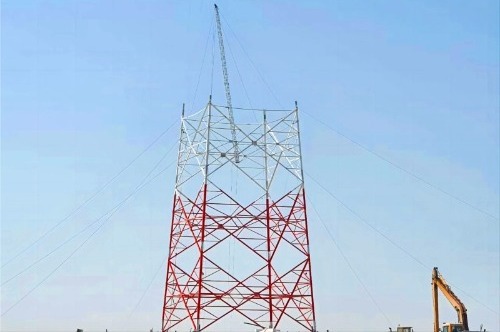Using steel poles for transmission lines offers several advantages over wooden or concrete poles. Here are some of the key benefits of using steel poles:
1. Strength and Durability:
- Steel poles are extremely strong and have a high strength-to-weight ratio compared to wooden or concrete poles.
- Steel poles can withstand higher wind loads, ice loads, and other environmental stresses, making them more durable and reliable in challenging conditions.
2. Longevity and Low Maintenance:
- Steel poles have a longer lifespan compared to wooden poles, as they are not susceptible to rot, decay, or termite damage.
- Steel poles require minimal maintenance over their lifetime, reducing operational costs and the need for frequent inspections and replacements.

3. Fire Resistance:
- Steel poles are non-combustible and offer better fire resistance compared to wooden poles, making them a safer option in areas prone to wildfires.
4. Environmental Benefits:
- Steel poles are more environmentally friendly than wooden poles, as they do not require trees to be cut down for production.
- Steel is a recyclable material, making steel poles a sustainable choice with lower environmental impact.
5. Customization and Design Flexibility:
- Steel poles can be designed in various shapes and sizes to accommodate specific transmission line requirements.
- Steel poles offer more design flexibility compared to concrete poles, allowing for customized solutions based on project needs.

6. Corrosion Resistance:
- Steel poles can be coated with protective coatings, such as galvanization, to enhance their resistance to corrosion and extend their lifespan.
- This corrosion resistance ensures that steel poles maintain their structural integrity even in harsh weather conditions.
7. Higher Load-Carrying Capacity:
- Steel poles have a higher load-carrying capacity compared to wooden or concrete poles, allowing them to support heavier power lines and equipment.
- Steel poles are suitable for high-voltage transmission lines and applications requiring greater structural strength.
8. Safety and Stability:
- Steel poles provide excellent stability and structural integrity, reducing the risk of pole failure or collapse.
- Steel poles are less susceptible to damage from impacts or external forces, enhancing overall safety for both the infrastructure and personnel.
In summary, steel poles offer superior strength, durability, longevity, and environmental benefits compared to wooden or concrete poles for transmission line applications. The use of steel poles can result in a more reliable, cost-effective, and sustainable transmission infrastructure that meets the demanding requirements of modern electrical transmission systems.

Learn more at www.alttower.com































